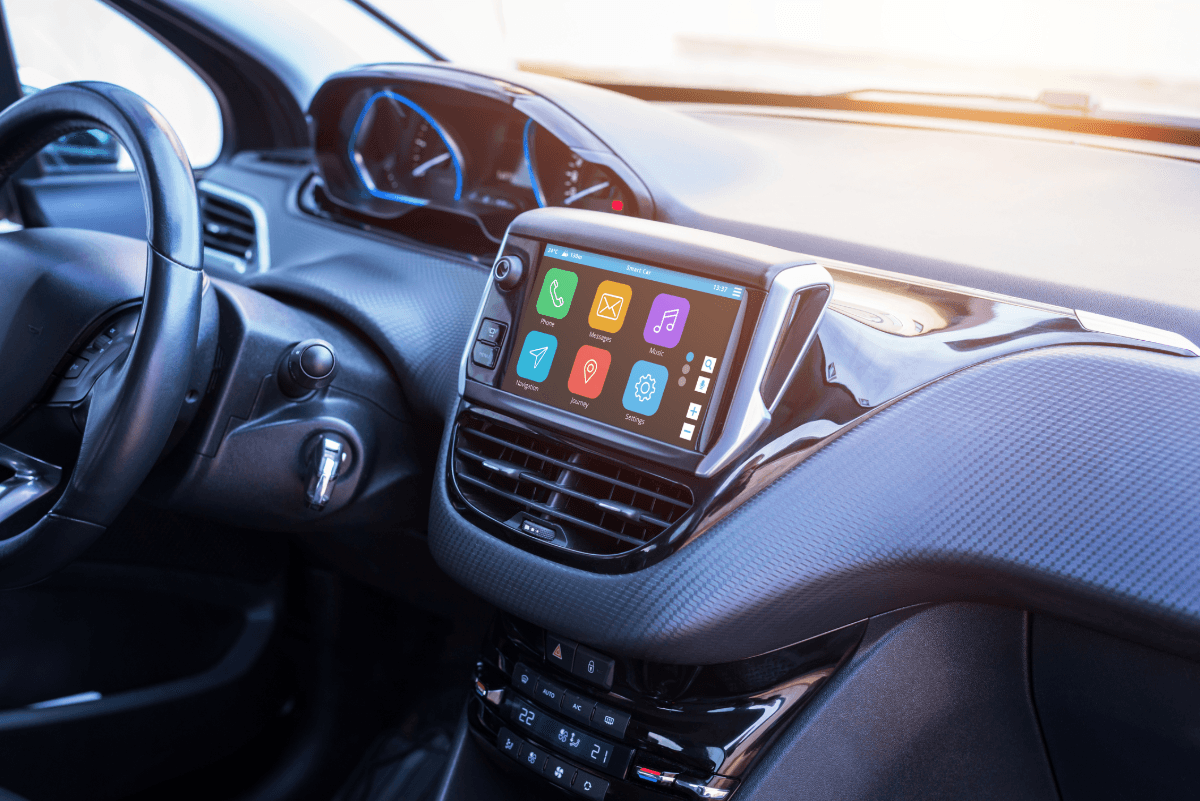
USA
Thank you for reaching out to Sigma Software!
Please fill the form below. Our team will contact you shortly.
Sigma Software has offices in multiple locations in Europe, Northern America, Asia, and Latin America.

USA

Sweden

Germany

Canada

Israel

Singapore

UAE

Australia

Austria

Ukraine

Poland

Argentina

Brazil

Bulgaria

Colombia

Czech Republic

Hungary

Mexico

Portugal

Romania

Uzbekistan
The usual purpose of a vehicle – fast and safe transportation – has been recently extended to new ones, such as getting information, communication, and entertainment. These new systems are called infotainment or, in this case, IVI – in-vehicle infotainment.
Today we are talking with Alexey Syrotyuk, Head of Innovations Department and coordinator of Infotainment track in Sigma Software.
Alexey, where did the infotainment concept come from?
As the term itself suggests, it is a blending of words ‘Information’ and ‘Entertainment’. It means conveying information in a fun way or in a way that does not distract people from their current tasks and requires minimal additional time.
The term is not new, but it gained new popularity with the development of onboard computers in cars and other vehicles – buses, trucks, planes. Such systems became known as in-vehicle infotainment (IVI).
Let’s talk about them. The development of in-vehicle systems started a long time ago (although the term itself did not exist back then). The first car radio-receiver was launched for sale back in 1930. Many things have changed since then, but why is IVI becoming such a hot trend now?

The media is changing, and so do the style and means of information transfer. We have switched first from newspapers to radio and television, then to computers and smartphones, today even cars are becoming information media.
Modern onboard computers offer huge opportunities, just like other kinds of equipment that manufacturers keep perfecting. At the same time, many devices and technologies are becoming more affordable, which gives the opportunity to combine them and experiment right ‘in the comfort of your home’.
Simultaneous development of such directions as automated driving, connected cars, navigation systems, and transport telematics, as well as development of onboard devices, is contributing to new ideas emerging and infotainment systems moving ahead. Besides, the scope of ideas and possibilities is expanding rapidly thanks to fast development of systems and devices in the area of the Internet of Things.
How will infotainment affect development of businesses in other industries?
I think these systems can be applied anywhere. Even now, business owners can no longer stay away from growing needs of their customers.
A good example of this is how the service of calling a taxi is changing its shape. We have gone through several iterations and switched from phone calls to mobile applications, which allow not only to make an order, but also to track the car’s location (for me, this element belongs to infotainment) and to get information about both the car and the driver. Besides, these systems save statistics and include elements of socializing.

Tracking systems are used in planes for a long time already, so passengers can watch where the plane is flying at a particular moment in real-time. IVI systems are adopted by public transport as a means of everyday communication with passengers through advertisement, news reports, and useful information.
Or, let’s take quite different sphere – sports and fitness. Here, the number of solutions is endless and includes counters, timers, activity bands, fitness trackers, all those promising and motivating applications.
Probably, there is no such sphere where these trends have no influence or possibilities for development. This is hardly the characteristic of infotainment systems alone. Rather it is a general progress combined with people`s need for information and entertainment.
How will IVI systems be changing in the next decades?
It depends on how the entire media environment will be developing. If in 10-20 years information is transferred directly to people’s brains and space travel becomes commonplace, there will be In-spaceship Infotainment systems and corresponding protocols of data transfer.
If we look at things in a more realistic way, I think in-vehicle Infotainment will be developing hand in hand with virtual and augmented reality, as well as with self-driving and other automated systems. Besides, all systems will be more and more integrated. Strange as it may sound, but today’s devices and systems are ‘social creatures’, and they will get more interconnected for the purpose of even better interaction.
Another trend to mention is collecting, storing, and processing of information in Cloud with the help of Machine Learning algorithms for its further use by Infotainment systems.
What can Sigma Software offer to car manufacturers to make their cars “smarter”?
Sigma Software is gradually going to the full development cycle of IVI systems: from creating a prototype, preparing the hardware and embedded development, to Human Machine Interface, integration with numerous systems and the Cloud, where data from the systems is aggregated for further processing and analysis.
In the development process, we use such platforms as OpenCar, OpenXC, QNX, Android Auto, which allow us to create solutions faster. We actively develop custom software for the automotive industry, utilizing the possibilities of real-time kinematics, and take part in projects on creating complex systems for autonomous driving.
We also continue to develop extensions for in-built Infotainment systems, which interact with the car’s CAN bus and onboard computer. These systems help to control and plan the logistics and fuel consumption, driving style, as well as working modes of the car.
We keep developing our expertise in this area and, what’s important, we keep enjoying every new project and particularly the process of fine-tuning and testing such systems.

Sigma Software Group provides IT services to enterprises, software product houses, and startups. Working since 2002, we have build deep domain knowledge in AdTech, automotive, aviation, gaming industry, telecom, e-learning, FinTech, PropTech. We constantly work to enrich our expertise with machine learning, cybersecurity, AR/VR, IoT, and other technologies. Here we share insights into tech news, software engineering tips, business methods, and company life.
Linkedin profile

A Software Bill of Materials (SBOM) is becoming one of the most important documents in modern software development. Still, many organizations struggle to create...

As cloud sovereignty becomes a strategic priority across the EU, Sigma Software applies its deep expertise and extensive experience to contribute to the develop...

Data is everywhere, yet its payoff isn't always there. Many IT leaders struggle with scattered analytics, rising storage costs, and unclear returns.We face...
Would you like to view the site in German?
Switch to German